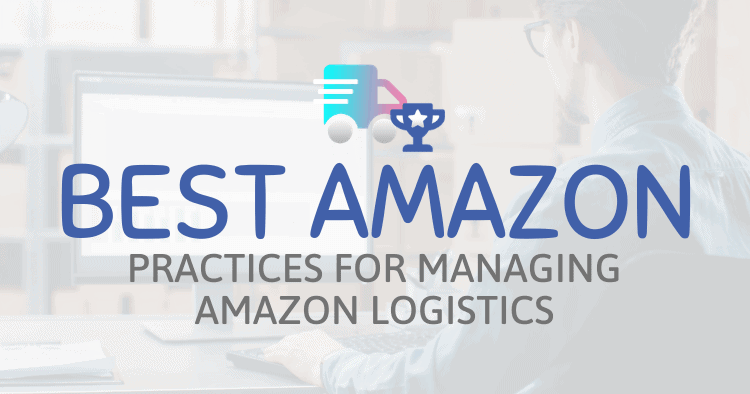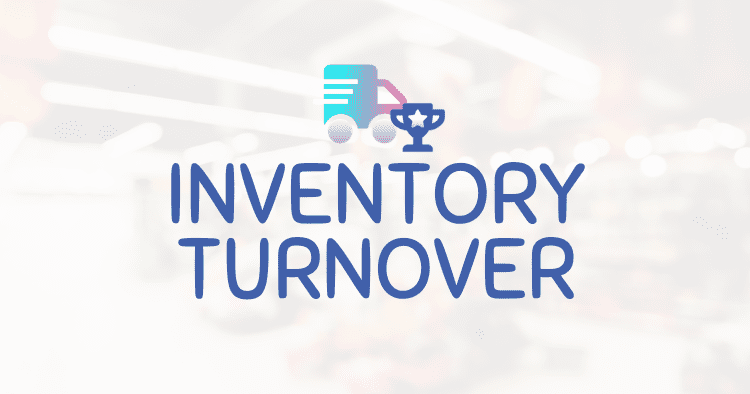
Best Practices for Managing Amazon Logistics
Amazon Logistics, Metrics, & Practices That Matter
The heart of every Amazon business lies in Amazon logistics. While talking about front-end strategies such as advertising and marketing is essential, an Amazon seller cannot function without logistics. One of the many keys to achieving success lies in learning and adopting the best inventory management and cash flow strategies.
Amazon logistics can make or break your business. If you manage this field well, you get rewarded with more profit and a higher valuation. If not, you get slapped with IPI restrictions that make your life harder.
Let’s talk about how you can start improving your logistics administration, beginning with the vital parameters you need to understand.
In this Amazon Logistics guide, we’ll take a look at:
The Amazon Logistics Metrics That Matter Most
Inventory Turnover Metric For Managing Amazon Logistics

One of the most important metrics to track when it comes to running a business is inventory turnover, also known as sell-through. It is a measure of the number of times you sold out an entire batch of inventory over a given period. One turn refers to selling out one whole inventory batch.
You can think of Inventory Turnover as comparable to the ROI metric (Return on Investment). When you sell out an entire batch of inventory, you recoup your investment. On top of that, you also earn a certain amount of profit on that investment.
You now have the money you need to make another investment, which is good because it means you don’t have to borrow money or go into debt to make your next investment. The faster your turnover, the faster you can get that money working for you again and therefore, the more you can potentially make on that same initial investment over time.
Inventory Turnover is a significant measure that is important to track. Most of the cash in a business is locked in inventory. If your merchandise isn’t selling, you don’t have any liquidity to meet your daily expenses. Inventory Turnover lets you improve the liquidity and efficiency of a business.
Even your Amazon IPI (Inventory Performance Index) score is essentially a reflection of your Inventory Turnover. IPI scoring factors such as excess inventory and the rate of inventory sell-through, are just two ways of looking at Inventory Turnover.
Pro Tip: Here are four ways to improve your Amazon IPI score if you’re currently dealing with Amazon IPI limits.
MOQ (Minimum Order Quantity) Metric For Managing Amazon Logistics

Small businesses usually don’t have the negotiating power required to get a lower MOQ from their supplier. Nevertheless, it is possible to work within your MOQ and still maximize your profit by decoupling your front-end from your MOQ.
As you grow, talk to your seller and create a buffer from which you can order. This means you would be meeting your MOQ but then having your supplier hold inventory for you and ship out smaller quantities over time, only requiring you to pay for the inventory that you will be shipping out.
By doing this, even though you still have to order large quantities, it will feel as if you’re getting smaller and faster shipments. Thus, your business velocity increases and your cash flow improves, freeing up capital to increase marketing spend, launch more products or otherwise invest in your business.
Your supplier should be open to such an arrangement, provided you adopt a cooperative win-win mindset. You’re asking them to help you increase cash flow to help you to scale, which is also a win for them as an increase in your sales and catalog translates to more orders for them.
Pro Tip: Don’t fall for the MOQ trap when dealing with Amazon suppliers. Here are 12 tips for a successful Amazon supplier negotiation strategy.
Days of Sales Metric For Managing Amazon Logistics

Another vital metric to keep in mind when evaluating your Amazon logistics is the Days of Sales measure. It’s essential to think about how many days of sales you have in your pipeline and how many you need to have.
Days of Sales refers to the average quantity of merchandise you sell in a day compared to your total inventory on hand. Calculating it is pretty straightforward – simply divide your total inventory by your average daily sales velocity. The resulting figure will be the number of days that your stock will last you.
Using your supplier lead times and other data, create a target for the number of days’ worth of inventory needed to ensure that you never stock out. This target should account for transfer times, and it should incorporate an amount of buffer stock as a safeguard against unforeseen circumstances.
Pro Tip: Another way to minimize stock-outs is to use an Amazon inventory management software like SoStocked.com.
Sales Velocity Metric For Managing Amazon Logistics

The velocity of sales is an obvious metric to track that most businesses gloss over. Market trends change, and correspondingly, an item’s sales do too.
Many sellers get stuck on velocities from months ago, or only look at total monthly sales and stock their inventories based on old data. If you keep stocking up on a product that was your bestseller a few months ago but is now a slow-selling item, you’re wasting a lot of money. Additionally, total monthly sales as your benchmark for reordering is erroneous as it doesn’t account for sales spikes or stock outs.
An important thing to note here is that you mustn’t focus only on your top few products. Track the velocities of all the products in your lineup. By doing so, you ensure that you are in tune with the data and immediately adapt to market changes.
SoStocked.com automatically tracks your velocity based on past sales, seasonality, and even accounts for future marketing you’re planning.
Best Practices To Manage Amazon Logistics Effectively
Most sellers on Amazon don’t have the resources to assemble an entire team to manage Amazon logistics, but that’s okay because a team isn’t necessary. All you need to do is identify all the functions to execute and perform them yourself.
Note that you can’t perform all these roles simultaneously. You need to separate tasks and complete them individually. Some of these functions will be daily; some will be periodic.
Here are the four primary roles you need to adopt.
Role of the Boss In Amazon Logistics

As a business owner, your first and foremost job is to set a direction for your company. You must set targets and create strategies to meet those targets.
Spend some time and identify where you want your business to go and how big you want it to be. Is your endeavor just a one-time thing? Are you planning on eventually selling it, or do you want to grow it and make it your life? What direction do you want your company to take?
Once you’ve identified your goals, think about how you’re going to get there. What tactics are you going to adopt? Create your SOPs (Standard Operating Procedures). Identify the metrics you’re going to use to track your performance. How are you going to know whether you’re on track with your goals or not? Which market signals are vital to you, and how are you going to react to them?
These are all significant aspects of a business that you need to know before you can do anything.
These tasks are not regular ones. You don’t have to redo them very often, or at all for that matter. Just make sure that you review your circumstances once a year to ensure that you’re on track.
Now, we get to the functions that are more operational in nature.
Amazon Forecasting & Planning Logistics

Every business needs to plan its actions, and consequently, it needs predictions of future trends. What most companies get wrong here is that they use forecasts directly to make decisions about inventory replenishment.
Understand the nature of forecasting. The job of a forecast isn’t to predict sales; it’s to predict potential demand. To predict the weather, we feed in data about the weather, and we receive predictions about potential weather in the future.
Seeing as how we don’t have data about demand, we use sales as a metric to approximate it. The critical thing to remember here is that this is an imperfect metric. Your sales data from the previous data cannot accurately predict demands for the next year, just as one can’t today predict the weather for a year from now.
All forecasts will always be wrong as they attempt to make granular predictions over a long period. Just like with weather, short term predictions will always be more accurate than long term ones.
The question now arises, if you can’t entirely rely on forecasts, how do you make decisions regarding inventory management? The answer lies in deconstructing the process. Instead of making decisions months in advance, split it up into pieces, and make smaller and faster decisions. By batching your transfers, your business can be a lot more flexible.
Examine all your SKUs. Only place orders for the SKUs that have reached a point where it makes sense to order a full MOQ. Instead of restocking all your SKUs at the same time, have your inventory continually flowing. Place orders for SKUs when the need for a full MOQ arises, or as we discussed above, cut down the MOQ into smaller batches. The same is true of orders above MOQ. Often ordering 6 months of inventory just for a price break ends up more costly in terms of tied up capital than the savings that price break gives.
When you place large orders months in advance, it creates spikes in your expense flow. You pay a large amount of money in advance, and then again a few months later once you receive your shipment. You spend all this money without having even sold a single unit, which can be tricky for your cash-to-cash cycle.
By batching your orders, you have smaller and more regular expenses. As soon as a small batch of inventory arrives, you can quickly generate the cash you need to pay for your next shipment.
It also benefits your supplier. When a supplier has to make large shipments, they spend the entire advance on souring raw materials. Then, they have to wait a few months for the rest of the payment. As a result of this, they don’t receive their profit for months. Smaller, more frequent orders help to even out your supplier’s cash flow as well.
Batching orders is a sound basis for cooperation that mutually benefits both sides of the table.
Pro Tip: Make managing Amazon inventory forecasting and planning easier with a tool like SoStocked.com
The Role of the Manager In Logistics

As a manager, your operative role is to conduct internal and external control.
As a part of internal control, you check to ensure that your actions line up with what you planned. You examine your performance against the plans of action you had created.
For external control, you compare the market data and trends to what you had forecasted. Does the market align with what you had predicted?
A manager’s role is to use data for self-correction. It doesn’t matter if you went slightly off-course, as long as you regularly use feedback to course-correct.
Just ensure that, on average, you’re on track with your plans.
Ongoing Follow-Up and Maintenance

The fourth function is one that you need to perform daily or at the very least, weekly. There is certain information that you need to keep track of regularly. You must have full knowledge of your inventory.
Know what you have ordered, where it is in the pipeline, what’s in the production stage, what’s on a boat to the U.S., what is going through customs, and what is en route to your warehouse.
Unfortunately, this is not a process that can be automated. However, it’s made A LOT easier by using SoStocked as your Amazon inventory tracking software. Just communicate with your supply chain and then use SoStocked as your system to keep track of everything.
The importance of this function is that it allows flexibility. Say that, suddenly, there’s a new trend in the market that leads to an increase in demand for a less popular product. Now, you may not have adequate stock for this product to meet demand, but you may not. If you stock out, you lose all the potential profit you could have made by acting on this opportunity.
By knowing everything about your supply chain, you can contact your supplier and ask them to expedite a product’s shipment. If a product requires some changes, you can get them done quickly. You have the flexibility you need to take advantage of rapid shifts in market trends.
This flexibility is also a reason to batch your orders. If you buy large batches every few months, you distance your business from the market and any down trends could leave you with more inventory than you can reasonably move, thus tying up your capital and stalling your cash flow. By having smaller but more frequent orders, you can react to changes more quickly.
Another significant function worth mentioning here is the management of excess inventory. Do not merely get rid of all your excess at whatever price you can get. Evaluate your options for each SKU. Different SKUs deserve different action plans.
If something is costing you money, it makes sense to clear it out. However, if it is possible to still earn a profit by upcycling a product with improvements or waiting, it may be wise to move it to a warehouse until you can sell it.
How To Manage Amazon Logistics Effectively

When it comes to retail e-commerce businesses, a company’s valuation can be just 1-2 times its profit. In contrast, brick-and-mortar retail businesses have multipliers around 3-4 or even as high as 10x.
The reason this happens is that buyers are aware that most Amazon businesses are small and inefficient. They have to put in the effort to fix everything once they buy it. Thus, it leads to a lower valuation.
The most significant investment in retail is the investment in inventory. On top of this, most of your company’s profit isn’t liquid as it is tied-up in this inventory. By adopting effective practices for logistics, you can hold your profit in the form of liquid cash.
If you manage your Amazon inventory efficiently and put good systems, your buyer doesn’t have to do anything – they just have to grow your business. By showing your buyer this, you can increase your valuation dramatically. Additionally, the money you save avoiding stock outs and costly logistics expenses will also improve your brand value as you won’t be losing profit to logistics mistakes that lower bottom line valuation.
Final Tips For Better Amazon Logistics

Data is critical to the functioning of your business. Reliable data will lead you to the right decisions; garbage data will lead to garbage results. Consider hiring a firm that can evaluate your Amazon account and organize your data effectively. This process will include accounting for money that Amazon owes you for lost inventory and removing canceled transfers from your inbound shipments section.
The most important piece of advice you can follow is to act rationally. Do not guess. Don’t act on an impulse or “gut feel”. Make decisions after you do the math. Know what numbers matter and then always trust those numbers.
Keep your ear to the ground, and make sure you’re flexible enough to take advantage of every opportunity that pops up. That is the way to run a successful business.
Lastly, if you’re tired of inventory “guess stress” use SoStocked.com to manage inventory based on your data instead of your gut. Sync. Scale. And Stay in Stock.
 Start Your Free Audit
Start Your Free Audit